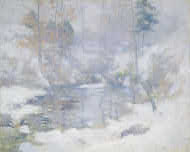
|
John Henry Twachtman (artist) American, 1853 - 1902 Winter Harmony, c. 1890/1900 oil on canvas Overall: 65.4 x 81.1 cm (25 3/4 x 31 15/16 in.) framed: 85.1 x 100 x 5.7 cm (33 1/2 x 39 3/8 x 2 1/4 in.) Gift of the Avalon Foundation 1964.22.1 |
Object 7 of 7
A native of Cincinnati who had studied in Munich and Venice, John Twachtman moved his family to a farm near Greenwich, Connecticut, within commuting distance of his teaching job in Manhattan. In two purchases of March 1890 and December 1891, he acquired more than sixteen acres, including the rocky bed of Horseneck Brook that opens into a quiet pond surrounded by a grove of hemlock trees. Shortly after signing the mortgage, he wrote to a fellow artist, "I can see now how necessary it is to live always in the country—at all seasons of the year. We must have snow and lots of it. Never is nature more lovely than when it is snowing. . . . That feeling of quiet and all nature is hushed to silence."
Winter Harmony is one of Twachtman's many studies of the pool on his property. The silver-gray tones and subdued blues and mauves evoke the evanescent transitions of light on an overcast day. The feathery touches of Twachtman's brush are very evident in the shimmering greens of the hemlock needles and the golden brown leaves that still cling to some branches. Unlike a French impressionist, who built up a scene with separate touches of color side by side, Twachtman adapted an old master technique of scumbling nearly dry paint into overlapping layers. He worked loosely so that the underlying tints and shades show through between the irregular, incomplete textures of covering strokes.
| « | back to gallery |


